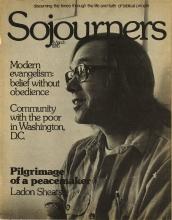From our office window, just three blocks down Vermont Avenue, the White House is clearly visible -- a symbol of the most powerful nation on earth. From the other office window, looking three blocks up Vermont Avenue in the opposite direction and just behind Luther Place Memorial Church on N Street and 14th, are visible three once nearly abandoned row houses where the core living group and most of the ministries of the Community for Creative Non-Violence are now centered.
CCNV, as it is know in a city filled with organizational initials, is in the central city ghetto just out of sight of the White House. District police estimate that within a ten block area on any given night, at least a thousand men and women walk the streets without shelter or money to buy food. Rachelle Linner, a 26-year old woman who has worked with the community since its beginning in January 1971, sees the community, like the neighborhood which surrounds it, as “a symbol of contradiction.” “We try to raise questions of values in the minds of people who are uninvolved. They can’t understand why we freely choose to live this way.” “Our very living arrangements,” says 40-year old Paulist priest Ed Guinan, now married, who began the community with others while a chaplain at Georgetown University, “carry both a theological and political judgment upon what is, and have created a defection and rupture from the secular/ecclesial arrangements.”
Ed Guinan did his seminary training in Washington DC in the late sixties after a short career in international finance in California. He asked the bishop at his ordination not to assign him to a parish but to let him start work among the poor in the city. His request to set up a community of people that would live poorly themselves and make themselves available to the poor was “unanimously approved, blessed, encouraged -- and separated.”
Read the Full Article

